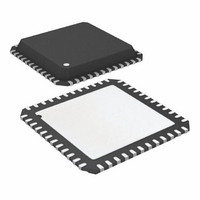ATA6613P-PLPW Atmel, ATA6613P-PLPW Datasheet - Page 56

ATA6613P-PLPW
Manufacturer Part Number
ATA6613P-PLPW
Description
MCU W/LIN TXRX REG WTCHDG 48-QFN
Manufacturer
Atmel
Series
AVR® ATA66 LIN-SBCr
Datasheet
1.ATA6612-EK.pdf
(364 pages)
Specifications of ATA6613P-PLPW
Core Processor
AVR
Core Size
8-Bit
Speed
16MHz
Connectivity
I²C, LIN, SPI, UART/USART
Peripherals
Brown-out Detect/Reset, POR, PWM, WDT
Number Of I /o
23
Program Memory Size
16KB (16K x 8)
Program Memory Type
FLASH
Eeprom Size
512 x 8
Ram Size
1K x 8
Voltage - Supply (vcc/vdd)
2.7 V ~ 5.5 V
Data Converters
A/D 8x10b
Oscillator Type
Internal
Operating Temperature
-40°C ~ 125°C
Package / Case
48-QFN Exposed Pad
Processor Series
ATA6x
Core
AVR8
Data Bus Width
8 bit
Data Ram Size
1 KB
Interface Type
SPI, TWI, USART
Maximum Clock Frequency
16 MHz
Number Of Programmable I/os
23
Number Of Timers
3
Maximum Operating Temperature
+ 125 C
Mounting Style
SMD/SMT
Minimum Operating Temperature
- 40 C
On-chip Adc
10 bit, 8 Channel
Lead Free Status / RoHS Status
Lead free / RoHS Compliant
- Current page: 56 of 364
- Download datasheet (7Mb)
6.6.5
56
Atmel ATA6612/ATA6613
Low Frequency Crystal Oscillator
Table 6-9.
Notes:
The device can utilize a 32.768 kHz watch crystal as clock source by a dedicated Low Fre-
quency Crystal Oscillator. The crystal should be connected as shown in
53. When this Oscillator is selected, start-up times are determined by the SUT Fuses and
CKSEL0 as shown in
Table 6-10.
Note:
Oscillator Source/
Power Conditions
Ceramic resonator, fast
rising power
Ceramic resonator,
slowly rising power
Ceramic resonator, BOD
enabled
Ceramic resonator, fast
rising power
Ceramic resonator,
slowly rising power
Crystal Oscillator, BOD
enabled
Crystal Oscillator, fast
rising power
Crystal Oscillator, slowly
rising power
Power Conditions
BOD enabled
Fast rising power
Slowly rising power
BOD enabled
Fast rising power
Slowly rising power
1. These options should only be used when not operating close to the maximum frequency of
2. These options are intended for use with ceramic resonators and will ensure frequency stabil-
1. These options should only be used if frequency stability at start-up is not important for the
the device, and only if frequency stability at start-up is not important for the application.
These options are not suitable for crystals.
ity at start-up. They can also be used with crystals when not operating close to the maximum
frequency of the device, and if frequency stability at start-up is not important for the
application.
application.
Start-up Times for the Full Swing Crystal Oscillator Clock Selection
Start-up Times for the Low Frequency Crystal Oscillator Clock Selection
Table
6-10.
Start-up Time from
Start-up Time from
Power-down and
Power-down and
Reserved
Reserved
Power-save
Power-save
16K CK
16K CK
16K CK
258 CK
258 CK
1K CK
1K CK
1K CK
32kCK
32kCK
32kCK
1kCK
1kCK
1kCK
Additional Delay
Additional Delay
14CK + 4.1ms
14CK + 4.1ms
14CK + 4.1ms
14CK + 65ms
14CK + 65ms
14CK + 65ms
14CK + 4.1ms
14CK + 4.1ms
14CK + 65ms
14CK + 65ms
(V
(V
from Reset
from Reset
CC
CC
14CK
14CK
14CK
14CK
= 5.0V)
= 5.0V)
(2)
(1)
(1)
(2)
(1)
(1)
(2)
(1)
Figure 6-12 on page
CKSEL0
CKSEL0
0
0
0
0
1
1
1
1
0
0
0
0
1
1
1
1
9111H–AUTO–01/11
SUT1..0
SUT1..0
00
01
10
11
00
01
10
11
00
01
10
11
00
01
10
11
Related parts for ATA6613P-PLPW
Image
Part Number
Description
Manufacturer
Datasheet
Request
R

Part Number:
Description:
MCU W/LIN TXRX REG WTCHDG 48-QFN
Manufacturer:
Atmel
Datasheet:

Part Number:
Description:
Ata6613
Manufacturer:
ATMEL Corporation
Datasheet:

Part Number:
Description:
BOARD DEMO LIN-MCM FOR ATA6613
Manufacturer:
Atmel
Datasheet:

Part Number:
Description:
DEV KIT FOR AVR/AVR32
Manufacturer:
Atmel
Datasheet:

Part Number:
Description:
INTERVAL AND WIPE/WASH WIPER CONTROL IC WITH DELAY
Manufacturer:
ATMEL Corporation
Datasheet:

Part Number:
Description:
Low-Voltage Voice-Switched IC for Hands-Free Operation
Manufacturer:
ATMEL Corporation
Datasheet:

Part Number:
Description:
MONOLITHIC INTEGRATED FEATUREPHONE CIRCUIT
Manufacturer:
ATMEL Corporation
Datasheet:

Part Number:
Description:
AM-FM Receiver IC U4255BM-M
Manufacturer:
ATMEL Corporation
Datasheet:

Part Number:
Description:
Monolithic Integrated Feature Phone Circuit
Manufacturer:
ATMEL Corporation
Datasheet:

Part Number:
Description:
Multistandard Video-IF and Quasi Parallel Sound Processing
Manufacturer:
ATMEL Corporation
Datasheet:

Part Number:
Description:
High-performance EE PLD
Manufacturer:
ATMEL Corporation
Datasheet:

Part Number:
Description:
8-bit Flash Microcontroller
Manufacturer:
ATMEL Corporation
Datasheet:










